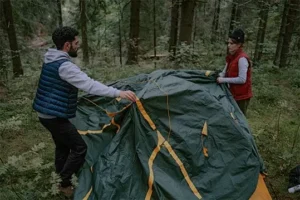In an increasingly eco-conscious world, sustainable travel has become a popular and responsible way to explore. By making conscious choices, you can minimize your impact on the environment, culture, and local communities. Here’s a short guide on how to be an eco-friendly explorer and contribute to a healthier planet while enjoying enriching travel experiences.
This blog is a thorough list of 25 ways to travel sustainably to encourage individuals to become eco-friendly explorers.
What is sustainable traveling?
Sustainable travel is also known as eco-friendly travel or responsible travel. It is the practice of seeing the world while having as little adverse impact as possible on the environment, native cultures, and communities. It emphasizes deliberate decision-making to protect the environment, boost regional economies, and preserve cultural assets for the benefit of present and future generations.
Importance of Sustainable Travel
It plays an important role in protecting the environment and local communities. The carbon footprint of the travel industry is substantial, accounting for approximately 8% of global greenhouse gas emissions. (Source: sustainabletravel.org )
Travelers can reduce their carbon footprint by adopting eco-friendly practices. This can be useful in limiting habitat destruction and protecting wildlife. Additionally, by joining responsible tourism initiatives, we can support local businesses and help them rise economically and socially.

Three Pillars of Sustainable Travel
These pillars serve as the core of responsible and eco-friendly tourism practices. It promotes a balanced approach to travel that benefits both the destination and the passengers.
The Environmental Pillar
The environmental pillar aims to reduce how negatively traveling affects the environment and wildlife. This involves conserving water, cutting back on water use, reducing packaging, and plastic waste, and not disturbing wildlife. By bringing your reusable items, we can make a simple difference as mindful travelers. We can search for accommodations and cafes or restaurants made of recycled and environmentally friendly components.
The Social Pillar
The social pillar focuses on how we affect the local population and communities. This includes supporting businesses that are run by, employ, and support local people, as well as community tourism projects, NGOs, social enterprises, and charities. Travelers who are responsible can look for ways to get involved in these kinds of projects and can research the companies they plan to visit to find out whom they use how much they pay them, and how well their workplace is secure.
The Economic Pillar
The economic pillar traditionally refers to a company’s ability to maintain itself through profitability. However, we may use the economic pillar to use our money in a way that will help the local economy when it comes to sustainable tourism. We can help the local economy by spending our tourist dollars with locally owned hotels, restaurants, and tour operators.

Tourism Environmental Issues and Sustainable Travel
The rapid growth of travel and tourism has given rise to environmental challenges around the world. Popular destinations face habitat destruction and overcrowding due to mass tourism. And air travel contributes to climate change through higher greenhouse gas emissions. Excessive tourist activities lead to water scarcity and pollution, and infrastructure development leads to habitat degradation. Unsustainable tourism promotes deforestation and wildlife disturbance.
Sustainable travel addresses these issues by promoting responsible practices. Travelers can make a positive impact by choosing eco-friendly transportation, conserving water, supporting sustainable housing, and respecting wildlife and local cultures. An emphasis on environmental stewardship helps preserve the beauty of the sites for future generations.
25 Ways To Be a Sustainable Traveler
1. Choose Eco-Friendly Accommodations
Go for hotels, lodges, or guesthouses that prioritize eco-friendliness. Look for certifications like LEED or eco-labels that indicate the property’s commitment to sustainability. These accommodations often implement practices such as energy conservation, waste reduction, and the use of locally sourced materials.
2. Support Local Businesses
When traveling, support local businesses and communities by buying from local artisans and vendors. This not only helps the local economy but also promotes cultural exchange and preserves traditional crafts and practices.
3. Pack Lightly and Responsibly
Pack only what you need to minimize weight and reduce carbon emissions during transportation. Use reusable and eco-friendly toiletries and avoid single-use plastics to minimize waste generation. Learn about what to pack on a road trip.
4. Choose Sustainable Transportation
Go for eco-friendly transportation options whenever possible. Travel by train or bus instead of flying short distances, as planes have a higher carbon footprint. If you must travel, think about reducing your carbon footprint by aiding carbon offset projects.

5. Respect Local Cultures and Traditions
Be respectful of the local customs, traditions, and beliefs. Educate yourself about the culture before visiting and follow their guidelines and dress codes when visiting religious sites.
6. Reduce Water Usage
By taking shorter showers and reusing towels. In areas with water scarcity, be extra mindful of water usage to support the local community.
7. Consume Local and Sustainable Food
Try local cuisines and choose restaurants serving sustainably sourced and organic food. This supports local farmers and reduces the carbon footprint associated with importing food from distant locations.
8. Use Public Transportation or Biking
Explore your destination using public transportation or by renting bicycles. It not only reduces your carbon footprint but also allows you to experience the city like a local.
9. Say No to Wildlife Exploitation
Avoid engaging in activities that exploit wildlife, such as riding elephants or taking photos with captive animals. Choose ethical wildlife experiences that focus on the conservation and protection of animals.
10. Participate in Community-Based Tourism
Support community-based tourism initiatives that empower local communities and provide them with a sustainable source of income.
11. Reduce, Reuse, Recycle
Follow the familiar mantra of reducing, reusing, and recycling waste. Dispose of trash responsibly and use recycling facilities when available.
12. Volunteer for Sustainable Projects
Consider volunteering for local conservation projects or initiatives that promote sustainable practices in the area you visit.
13. Offset Your Carbon Footprint
Calculate your travel’s carbon footprint and offset it by investing in renewable energy or reforestation projects.
14. Choose Eco-Friendly Tour Operators
When booking tours or excursions, go for companies that prioritize sustainability and responsible tourism.
15. Stay on Marked Trails
When hiking or exploring nature, stick to marked trails to protect the local flora and fauna from unnecessary damage.
16. Be Mindful of Energy Consumption
Turn off lights, air conditioning, and other electronic devices when not in use to conserve energy in your accommodation.

17. Support Conservation Initiatives
Donate to or participate in conservation organizations working towards protecting the environment and wildlife.
18. Educate Others
Spread the message of sustainable travel and inspire others to adopt eco-friendly practices when they travel.
19. Avoid Over-Tourism
Choose off-season travel or explore lesser-known destinations to avoid contributing to over-tourism in popular hotspots.
20. Learn Sustainable Travel Tips
Educate yourself on sustainable travel tips and share them with fellow travelers.
21. Respect Wildlife and Marine Life
Avoid touching or disturbing wildlife and marine animals when snorkeling or diving. Keep a safe distance to protect their natural behavior.
22. Say No to Plastic Souvenirs
Refuse to buy souvenirs made from single-use plastics or other unsustainable materials.
23. Support Eco-Friendly Initiatives
Stay informed about eco-friendly initiatives and support businesses and destinations that take environmental conservation seriously.
24. Use Reef-Safe Sunscreen
When swimming in coral reef areas, use reef-safe sunscreen to protect marine ecosystems from harmful chemicals.
25. Travel Slowly and Mindfully
Avoid rushing from one attraction to another and take the time to immerse yourself in the local culture and environment.
FAQs
Q1. What is sustainable travel?
Sustainable travel involves making conscious choices to minimize our environmental impact while exploring new destinations.
Q2. How can I help out the locals while I’m traveling? Support local businesses, artisans, and community-based tourism initiatives to contribute positively to the local economy.
Q3. Are eco-friendly accommodations expensive?
Eco-friendly accommodations come in a range of prices and some budget-friendly options are available too.
Q4. Why is it important to avoid wildlife exploitation?
Wildlife exploitation can harm animals, disrupt ecosystems, and contribute to unethical practices.
Q5. Why is sustainable travel important?
Sustainable travel is essential for preserving natural resources, supporting local economies, and protecting cultural heritage, ensuring a better future for the planet.





Pingback: Safe Travel Tips: What You Need to Know to Have a Great Trip 2023 - TravelGaze